NorthEast Radio Watch 12/8/2025: Cichon’s Back in Buffalo
In this week’s issue… Veteran newsman returns - Remembering NY's Leitner, RI's Jones - CT AM saved - Maine AM moves - "Indie" adds suburban signals
Text and photos by SCOTT FYBUSH
After enjoying a few delightful days of radio, spring training baseball and sunshine in Florida in late February, it was time to point the car up I-95 for a long slog back north in questionable weather. It was so rainy in Fayetteville, N.C. that I didn’t even drive around looking at towers after an overnight stay, but it got nicer a day later when I pulled into the DC area to spend a couple of nights with friends before making the last leg of the trip back home.
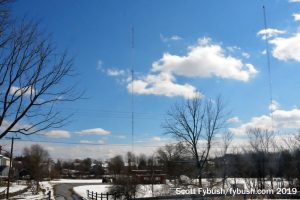
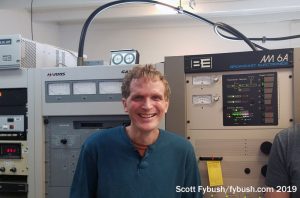
And on the way, I had the chance to stop and see what I had heard on the way down: the all-digital AM testing that Hubbard Radio was conducting over WWFD (820) in Frederick, Maryland. The WWFD plant is right off the side of I-70 on the west side of Frederick, a location I’d driven by plenty of times without ever getting a chance to peek inside.
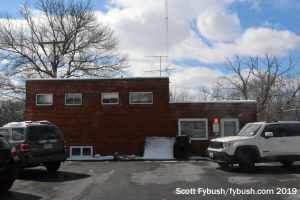
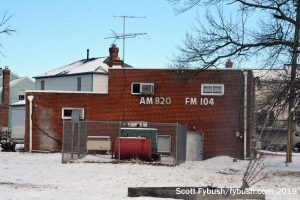
In fairness, there hadn’t been much activity inside this building for quite a while. This was a local station for Frederick from the time it signed on as daytimer WMHI on 1370 back in 1961 until 2000, when it became part of a simulcast with then-Bonneville’s Washington cluster. For much of its local time, it was WZYQ, a top-40 format that migrated from the AM to its sister FM on 103.9. The AM side migrated from 1370 to 820 in the late 1980s, rearranging the towers into the present two-tower DA. Since 2000, these signals have been used to extend the reach of several different DC-based formats: the FM is now WTLP, relaying all-news WTOP (103.5) to listeners who commute up the busy I-270 corridor, while the AM relayed Federal News Radio WFED (1500) before picking up the eclectic “Gamut” music format that Hubbard engineer Dave Kolesar programs on WTOP’s HD3.
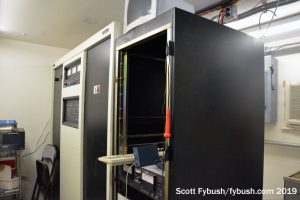
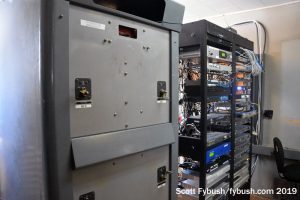
WWFD recently got an FM translator for the “Gamut” programming, and that left the AM facility available for some experimentation when the opportunity presented itself. Dave and the Hubbard crew had a long history of working with the HD Radio developers down the road in Columbia, Maryland, including early tests of AM HD technology over an experimental expanded-band AM signal that was diplexed into one of the WWFD towers here.
So when the HD folks (under their current corporate ownership, Xperi) wanted to try out all-digital AM, replacing the analog signal at the center of the AM station’s bandwidth with more robust digital carriers, Hubbard offered up WWFD as a test bed. Beginning in July 2018, WWFD turned off its analog signal and disappeared from analog-only AM radios. Instead, anyone with an HD-equipped radio in their car or even their home could tune to 820 and (after a few seconds of acquisition time) hear an all-digital signal that turned out to be much more effective than 820’s old analog reach had been.
How much more effective? On the way south, we started hearing WWFD in digital as far north as York, Pennsylvania, and we carried it well south of Washington. On the way north, it remained audible in spots past Harrisburg, more than 70 miles north of Frederick.
(And that, we should note, was before WWFD upgraded its transmitter – more on that in a moment!)
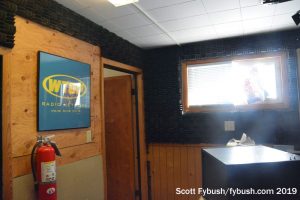

Let’s pause here for a moment to take a walk through this building. It’s a split-level plant, with a main floor that held the reception area and a manager’s office that’s been converted to a transmitter room for 820. (Just after we drove away, they installed a new Nautel in this room to augment the BE and the Gates Five that had previously powered the 4300-watt day, 430-watt night signal here.)
A half-flight of stairs from the reception area leads up to the old WZYQ studios, which still look much as they did when last used in the late 1990s. The main studio looks into the old transmitter room, which still houses the phasor and the rack of equipment that brings the Gamut signal for 820 and the WTOP programming for WTLP 103.9 up from Washington.
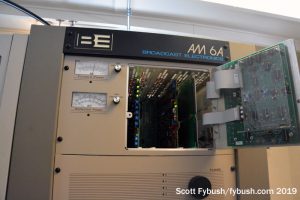
The half-flight down from the reception area leads to some storage areas and the utility room where a Harris DX10 had been installed for those X-band HD Radio tests – and then out to the towers in back.
As is typical of so many of these aging AM sites, the transmission system was in need of lots of TLC when the HD testing began. Dave and the Xperi crew spent plenty of time out here rebuilding the ATUs for the nice flat frequency response the all-digital (“MA3”) AM system requires. Even if WWFD eventually goes back to analog operation, it will end up as a better-sounding signal as a result.
But it’s probably not going back – there’s the translator at 94.3 to bring the Gamut to analog-only listeners around Frederick, and the all-digital signal can now be heard by perhaps 30% of potential listeners, not just here in Frederick but in much of metro Washington and Baltimore as well, areas the 820 signal couldn’t usefully cover in its analog days.
(One cool thing about the tuning houses at the tower bases: you know how an ATU typically “sings” with metallic audio from the AM signal? The ones at WWFD “sing,” too, but of course with the “whoosh” sound of the digital audio as it would be heard on an analog radio.)
We’re looking forward to making a return trip sometime soon, because Dave and the Xperi crew keep innovating here: the new transmitter allows for extended digital carriers that provide stereo audio, album art and have even allowed for testing a very experimental HD2 signal. (Existing radios have the all-digital HD1 system enabled in their firmware, but no existing radio can get HD2 on AM.)
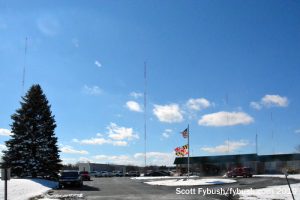
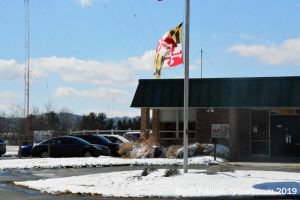
And what’s that right around the corner up the hill? The four-tower array of Frederick’s other AM station, WFMD (930), which had gone from iHeart to a divestiture trust and had just recently been sold to Connoisseur when I drove by. Its studios, shared with country FM sister WFRE (99.9), sit next to the towers – and look carefully in the distance between the WFMD array and the building: there’s WWFD’s two towers in the background!
We spent some time out here talking to Dave and Mike for our Top of the Tower Podcast, and it’s worth hearing what they had to say in March about these tests. (And just a few weeks ago, they spent time with our friends at This Week in Radio Tech to provide updates on how things have been going with the testing.)
One more thing – that lovely image of the WWFD towers at the top of the page? It’s in the new Tower Site Calendar 2020, now shipping. Order yours below!
Thanks to Dave Kolesar and Mike Raide for the tour!
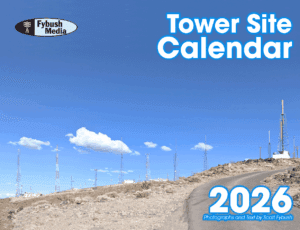
As we announced a few weeks ago, the 2026 edition of the Tower Site Calendar will be the last.
We began publishing it 25 years ago, and the broadcast landscape is radically different now.
Radio World just ran an excellent article about us if you want to know more.
Once it’s gone, that’s it. We won’t be printing any more.
Thank you to everyone who saw our announcement and rushed to buy it. We appreciate you.
(There are some calendars from previous years if you want more of a tower photo fix — all under $5.)
But don’t wait to get this year’s Tower Site Calendar — buy it now!
We are selling the Broadcast Historian’s Calendar again this year, but we have that in an even smaller quantity — definitely don’t hesitate for that.
And visit the Fybush Media Store to check out our selection of books and videos, too!
And don’t miss a big batch of Maryland IDs next Wednesday, over at our sister site, TopHour.com!
On January 3: WTOP’s new studios, Washington DC
In this week’s issue… Veteran newsman returns - Remembering NY's Leitner, RI's Jones - CT AM saved - Maine AM moves - "Indie" adds suburban signals
In this week’s issue… Scripps stations face takeover - Sinclair moves more affiliations - CT stations sold - Maine AM surrendered - Remembering WVBR's Shapiro, WABC's Morgan
In this week’s issue… CT TV legend succumbs to cancer - Remembering PA's Adams - FCC still stalled by shutdown - Pittsburgh morning host exits
In this week’s issue… FCC faces reopening challenges - Veteran Boston anchor retires - Morning shift in Toronto - NYC FMs expand reach